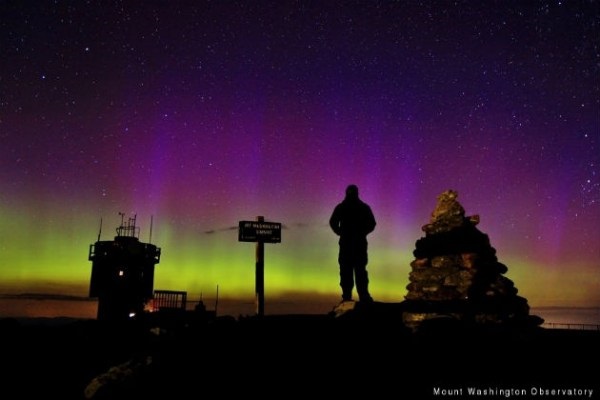Aurora Borealis
2017-07-18 13:27:44.000 – Jillian Reynolds, Summit Intern

Earth’s magnetic field guides the electrons such that the aurora forms two ovals approximately centered at the magnetic poles (NOAA, 2017). During major geomagnetic storms these ovals expand away from the poles such that aurora can be seen over most of the United States. One indicator of the magnitude of a geomagnetic storm is called the Planetary K-index (Kp-index). The Space Weather Prediction Center (SWPC) uses the K-index to decide whether geomagnetic alerts and warnings need to be issued for users who are affected by these disturbances (SWPC, 2017). K-index Warnings are issued when NOAA estimates Kp-indices of 4-7. K-index Alerts are issued when NOAA estimates Kp-indices reach 4-9. Stronger geomagnetic storms can start to disrupt satellite and radio communication.
Up here on the summit, we did have a chance to see the Aurora this past Sunday night. The Observatory crew and I kept checking the weather for after sunset and how strong the geomagnetic storm was throughout the day. We have received some Warnings issued from NOAA for the Kp-indices earlier in the day. Some of us stayed up late and went up to the observatory deck to keep an eye on the sky. The sky conditions were mostly clear and we could see stars. Unfortunately, we were unable to see the Aurora that night. One of the reasons for this was that the strongest levels of Kp-indices were seen before sunset (as seen below). It was still too light out to see anything. We were all upset, but are still hoping to see the Aurora some other night before the summer is over!
Jillian Reynolds, Summit Intern
Team Flags Return for Seek the Peak’s 25th Anniversary
Team Flags Return for Seek the Peak's 25th Anniversary By MWOBS Staff Mount Washington Observatory is looking forward to continuing a much-loved tradition for Seek the Peak’s 25th Anniversary: Team flags. In inviting teams
Meet Summer Interns Zakiya, Max and Maddie
Meet Summer Interns Zakiya, Max and Maddie By MWOBS Staff We are excited to welcome six teammates to the summit of Mount Washington this summer! During their internship, these students and graduates will play
Saying Goodbye to the Summit
Saying Goodbye to the Summit By Alexis George After an extraordinary last three years working as a Weather Observer and Meteorologist, I am excited to pursue a different career. As sad I as am




